Genre: Shmup Developer: Toaplan Publisher: Dreamworks Players: 1 Released: 1990
The shoot-em-up is just about the longest staple of video games. If games let you do anything, it’s shoot. Toaplan was the famed Japanese developer that probably did more to advance the vehicle shooter genre than anyone. With rare exceptions, shooters were all Toaplan cared about. At their best, they focused with a laser precision that probably hasn’t ever been bettered. Sadly, that’s partly because this style of games are rarely made anymore. This is a once-vibrant genre slowly headed for extinction.
I can’t imagine why anyone who loves video games would choose to live without a handful of shooters in their library. These are the very definition of instant-gratification, dazzling the senses and fraying the nerves in less time than it takes to read most instruction manuals. Casual players dominate the market now, and they want simple games; not simple to learn, but simple to walk through. Toaplan shooters cannot be easier to grasp – shoot or be shot – but they require a skillful combination of reflexes and memorization that punishes the casual.
There are a string of classics created by Toaplan from 1986’s Slap Fight to 1993’s Batsugun, each brilliant and somehow unique in its own way. Right in the middle of this pack lies Fire Shark. A close cousin to other Toaplan titles like Sky Shark and Twin Cobra, it features a bi-plane set against waves of tanks, boats, cannons, and airplanes, over cities, forests, oceans, deserts, and tundra. This isn’t a game that redefines shooters in any obvious way, but each element is fine-tuned to perfection, and retains a timelessness all its own.
Notice, first of all, your weapons. You begin with a three-shot spread as a default; most games would make you earn those extra bullets. This gun can be powered up three times; the final weapon fires a massive spread of bullets in a wide forward arc. The second weapon is more powerful but concentrated in a smaller wave in front of your plane. This is in keeping with the shooter convention that balances weapons between the weak-but-wide shot, the powerful-but-narrow shot, and the wild card. But never fear, the green beam takes up half the screen when fully powered.
The third weapon, the “wild card,” is one of the reasons I love Fire Shark so much. It is a flamethrower, but no ordinary flamethrower. It begins with one small column of flame that instantly destroys anything it touches, and then two columns. The third level is the pay dirt: two columns on each side, sweeping side-to-side. Level four: yet another two flaming columns, now covering your backside, sweeping and swaying. It’s a wonderful sight to behold.
And, yet, here is what really makes Fire Shark a classic shooter: it retains a sense of fairness and challenge. Owning the most powerful guns hardly guarantees an easy victory through the game’s ten stages; as the game progresses, you’ll be literally deluged from all sides, and no matter how many times I played through over the years, I could never remember just when and where everything would pop up. There’s always some damned plane that’s going to hit you on a blind spot, sooner or later. You will get shot down and start all over; and you will still have more than a fighting chance, even against the massive bosses.
There’s never been a more balanced shooter as far as I can remember. Ever. I can’t figure it out, why other developers have to choose between making it easy for the fully powered-up player and making it hard for you when you lose those weapons. Thunder Force 3 couldn’t do it (too easy). Aleste (all 350 of them) couldn’t do it. Gaiares sure as hell couldn’t do it; that game’s too hard even with all the power-ups. But Fire Shark has that balance, and it will never be done better.
Consider the enemy armies pitted against you. Tanks maneuver across terrain, following in formation, or sometimes just spinning in the sand. Trains will follow across a maze of tracks, as hidden cannons pop out of nowhere and disappear again. The boats sail in packs and always with air cover. And, of course, there are those planes. Most shooters would have planes travel a single-file line (ala Galaga and Gradius); the planes in Fire Shark swoop like crazed hawks, in straight lines, in waves, in cross-patterns, in every conceivable direction. It’s all such wonderful chaos.
The arcade original is good, but the definitive version of Fire Shark is easily the 1990 Sega Genesis version. This was released just as the Genesis was reaching its stride and remains just about the best shooter ever released on that wonderful console. The game’s graphics show such a sharp attention to detail, and terrific variety, throughout. Here’s another great game that remembers the pointless, little details. Notice the tiny, animated soldiers that await you at home base between each stage. In one moment, another plane crashes during takeoff. In another, one soldier breaks formation to watch you land; try not to chuckle when the Sergeant berates him.
Let us also pause to remember the thunderous, booming explosions, and that magnificent soundtrack. Here is one of the great guitar scores that made the Genesis the envy of many during the 16-bit era; that little black box could really churn out the sounds when in the right hands. It certainly owes something to ‘70s AOR rock; a little Blue Oyster Cult, a little Who, a little Zep. The original arcade’s audio is lost to emulation, possibly forever (the arcade’s custom audio board has never been cracked), so this is another reason why the home version is superior.
I’ll close with one final virtue to bestow upon Fire Shark: you can play the game forever. Once you complete all ten stages, once the credits have rolled, you play through the game again, on a harder (and I mean HARD) setting. This is really the thing that made Contra on the NES so perfect; you’d think this would be standard-issue for every console video game. You’d be wrong.
Originally printed at danielthomas.org.
SCORE: 10 out of 10

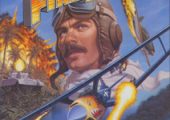
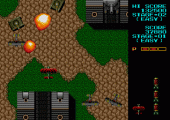
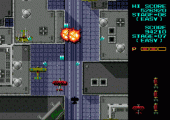
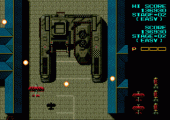
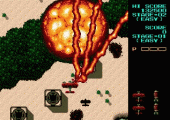
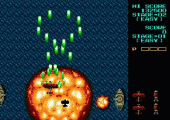
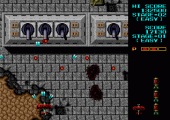
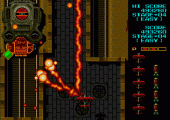
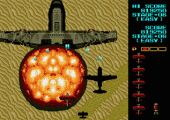
The only thing generic about this game is the plain looking label. Were it not for Toaplan on the label, this could be passed up as a low quality game.
Fire Shark has all of the action of Sky Shark done much faster, and with the necessary memorization of what attacks will come from behind like Truxton. Max speed and max power doesn’t prevent multi-hit gun turrets from firing their faster shots in later stages. Furthest I ever got on a single credit was Stage 8 on Normal.
great game! but why is it called fire shark?
I somewhat agree with Osquip. It’s not a 10/10 but definitely not a 6 either. It’s a pretty solid shooter. I’d give an 8.
Terribly biased review. This is a completely average shtump with no distinguishing characteristics. It’s not bad (far from it), but it’s nothing special. 6/10 at most